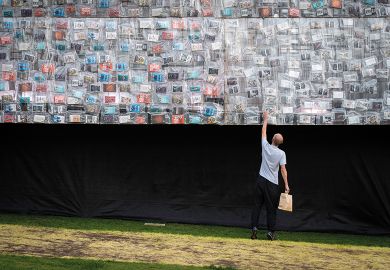Last month’s swift clarification that trade books will remain exempt from open access mandates at the UK’s next Research Excellence Framework was widely welcomed by researchers. However, the principle that all monographs submitted to the REF must, barring a few exceptions, be open access is still alarming.
That worry is particularly acute in subjects whose publications rely on numerous illustrations, such as my field of art history. Obtaining licences to use images in academic publications is already onerous and expensive. Some major US and European museums recently started making high-resolution photographs of their public-domain artworks reproducible without the need to negotiate a licence or fee, but that remains very much the exception. In most cases, each book illustration has to be individually negotiated and purchased.
Neither universities nor publishers are typically willing to cover such costs, which can run into thousands of pounds. Hence, they have to be met by authors themselves, despite publishing being a requirement of their employment contracts.
My concern is that negotiating the CC-BY licences on which open access requirements insist will cost even more. Image rights holders base their permissions (typically time-limited) and fees on factors that include the limited size of a typical academic print run and the paywalling of e-books, which make it relatively unlikely that images will be reused without permission and fee. Yet CC-BY licences allow unlimited reuse and republication subject to attribution of the original source. If rights holders offer such licences at all, they will surely do so at considerably higher prices, leaving art historians even more out of pocket.
Cash-strapped universities are also likely to be hit by the new REF rules – particularly, again, with regard to highly illustrated books. Publishers’ quoted fees for upfront (gold) open access tend to start at about £10,000 for a 100,000-word book containing up to 20 illustrations – if illustrations are mentioned at all. But 20 is very few for an art history book; between 50 and 100 is more typical.
Publishers will surely charge more for these highly illustrated open access books, if not because they involve more typesetting then simply because they are a deviation from the sparsely illustrated norms on which open access guideline prices are based.
Will universities be willing to pay fees in excess of £10,000? I don’t know. But I am aware that publishers are already quoting individual prices far in excess of this sum, and not just in art history either.
THE podcast: what is open access?
The worst-case scenario is universities unwilling to cover the full hiked costs will simply pull out of subjects such as art history. Departments are already small and the humanities in general are being dismantled. No one would want the REF to be a mechanism for further threatening a valuable discipline’s future.
Of course, these proposals do allow for books containing third-party material to be exempt from the REF requirements as long as the author’s final printed text is made publicly available online within 24 months of the printed book’s publication. This will be the cheap option for art historians and departments to comply with the REF rules.
But this risks UK art history becoming a discipline with two versions of most books: the illustrated print book and an unillustrated PDF of a Word document, with different layout and page numbers. The latter’s greater availability is likely to make it more widely read, but it will be a grossly diminished product – art history without the art. Moreover, that wider readership for the OA version might prompt publishers to simply stop publishing monographs in art history – or, indeed, in any other subject in which print readership significantly falls.
Perhaps, given all these issues, art historians would be better off sticking to journal publications. But books remain the gold standard in our discipline, as consistently proved by REF results. It is harder to develop original, rigorous and significant research in an article.
Hence, those with private wealth who can afford open access fees will still publish books, benefiting from the career progression that they bring. Those confined to journal articles will be at an unfair disadvantage. More broadly, however, the whole discipline of art history will suffer from declining REF scores if significant numbers of art historians give up on books – and the attendant decline in both reputation and quality-related research income would offer managers two more reasons to close whole departments.
Of course, I can see the benefit of making long-form, fully illustrated research freely available, and I greatly value the open access art history books I have been able to access. But, to date, these have been made possible mainly by the significant publishing resources of key research institutions, such as the US’ Getty Research Institute and the UK’s Courtauld Institute.
It is fanciful to assume that university art history departments, let alone their individual members, have the resources to follow suit. If the REF really wants art history to be fully open to everyone, it is going to have to go back to the drawing board.
Francesca Berry is associate professor of history of art at the University of Birmingham, where she is head of research in its School of Languages, Cultures, Art History and Music.
Register to continue
Why register?
- Registration is free and only takes a moment
- Once registered, you can read 3 articles a month
- Sign up for our newsletter
Subscribe
Or subscribe for unlimited access to:
- Unlimited access to news, views, insights & reviews
- Digital editions
- Digital access to THE’s university and college rankings analysis
Already registered or a current subscriber? Login








